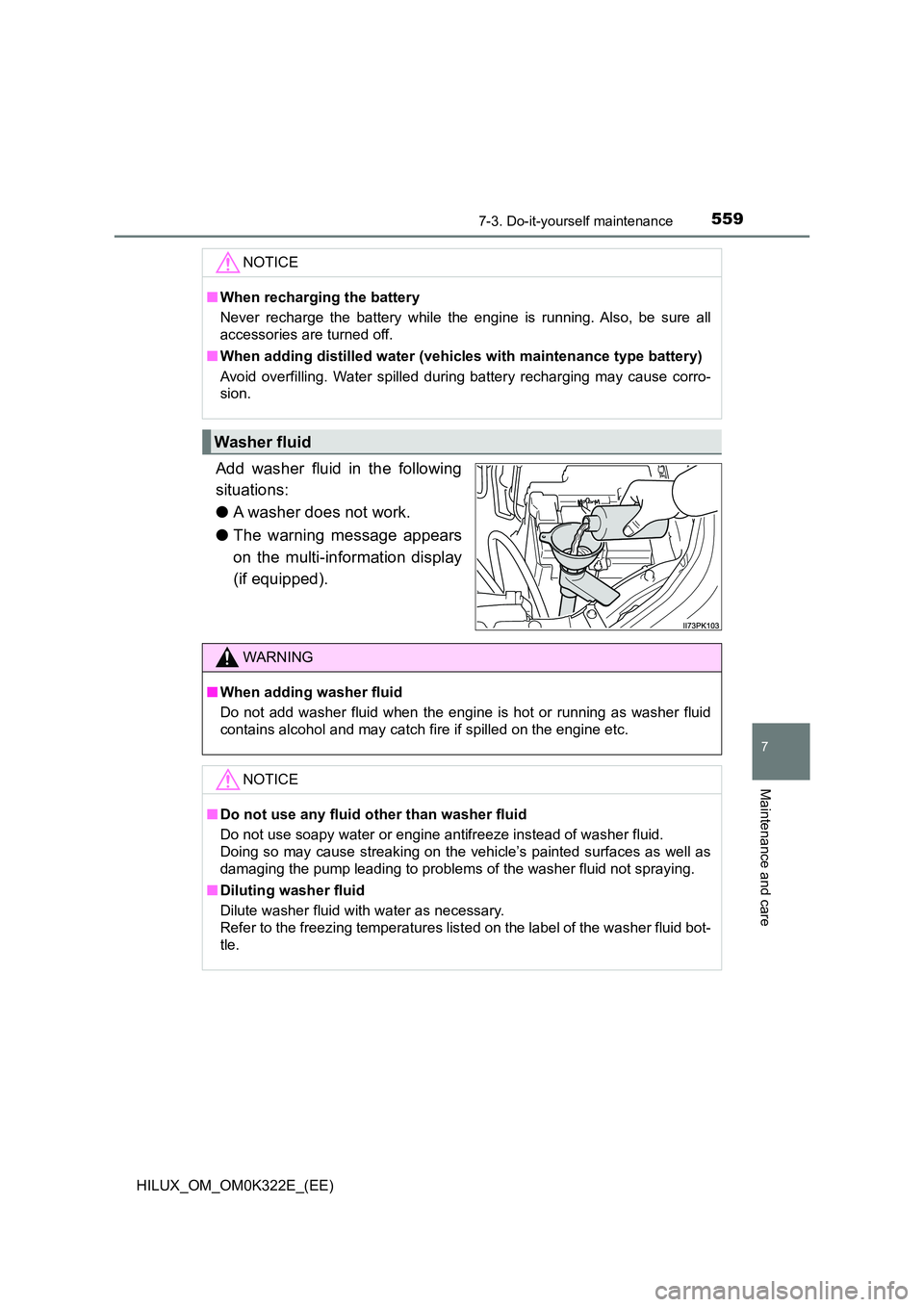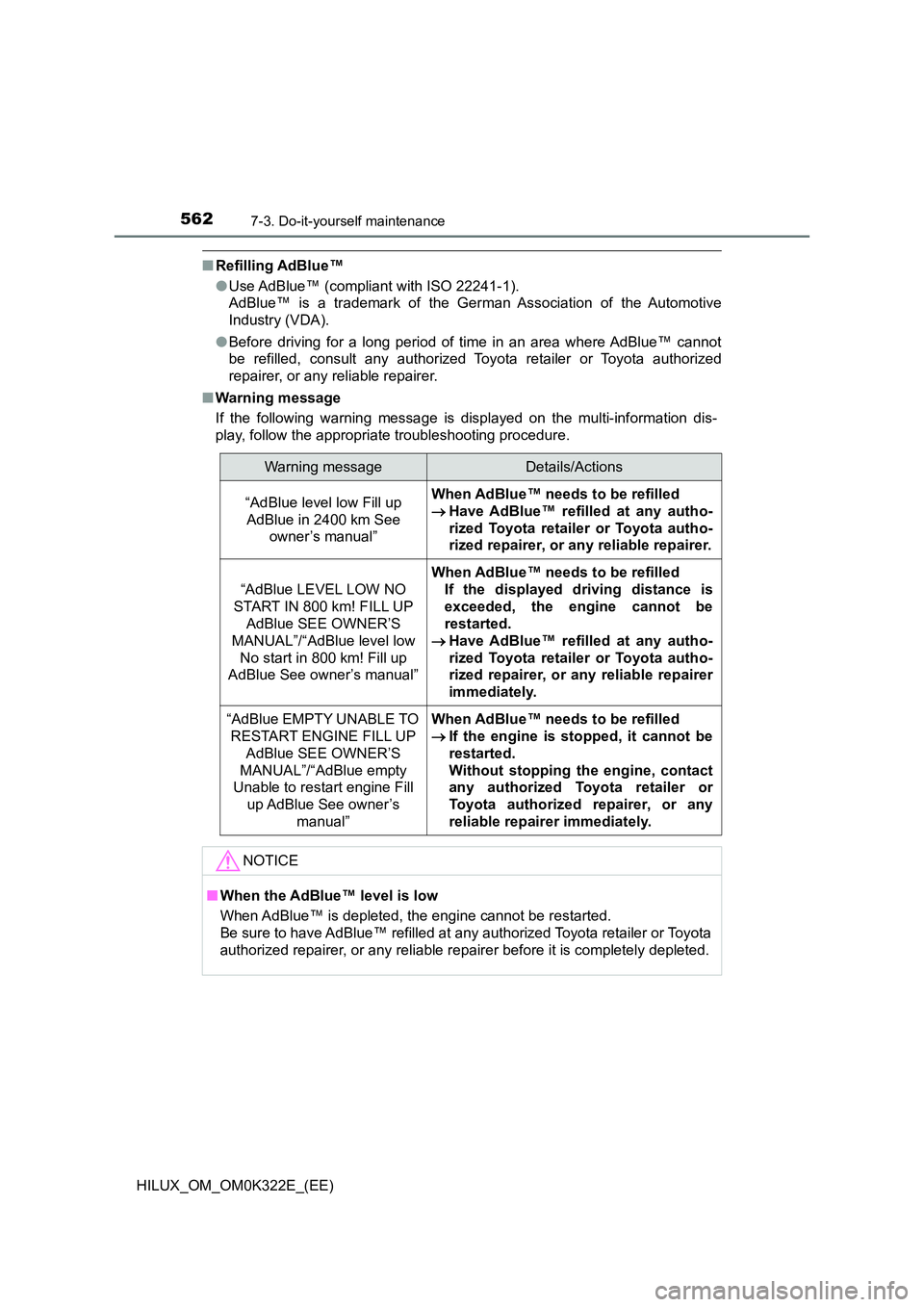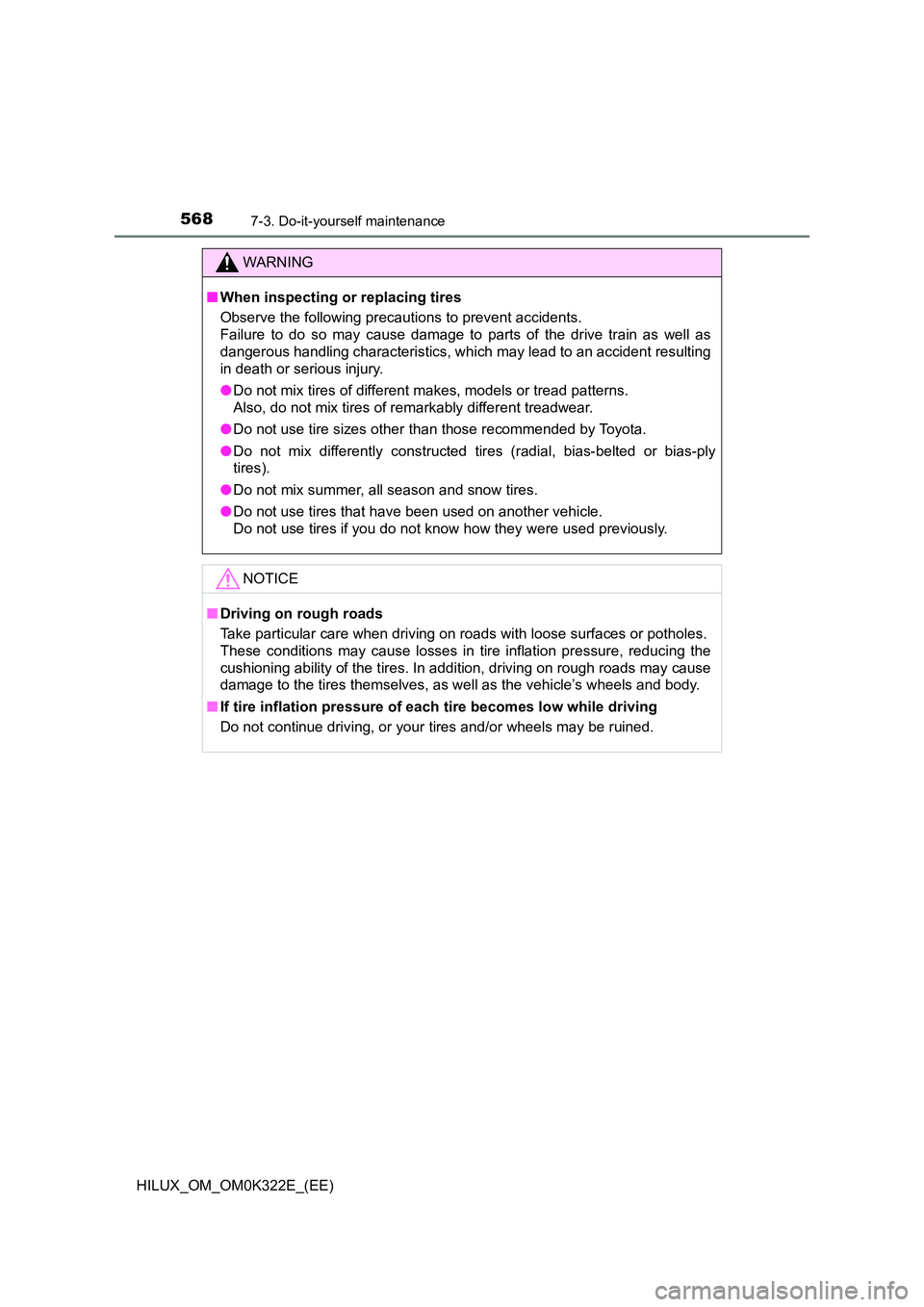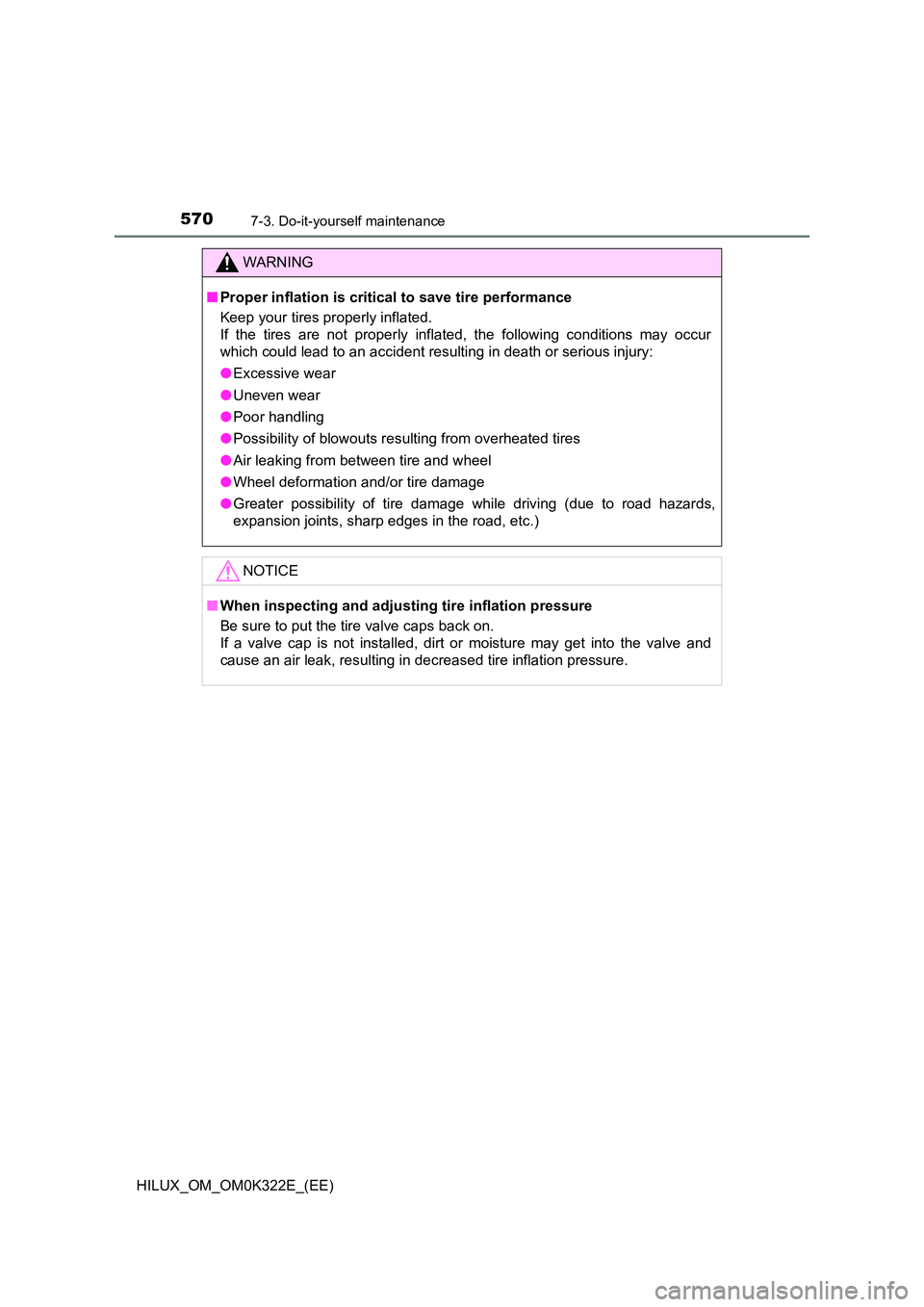2017 TOYOTA HILUX warning
[x] Cancel search: warningPage 554 of 720

5547-3. Do-it-yourself maintenance
HILUX_OM_OM0K322E_(EE)
Check the radiator, condenser and intercooler and clear away any for-
eign objects. If any of the above parts is extremely dirty or you are not
sure of their condition, have your vehicle inspected by any authorized
Toyota retailer or Toyota authorized repairer, or any reliable repairer.
WARNING
■ When the engine is hot
Do not remove the radiator cap or the engine coolant reservoir cap.
The cooling system may be under pressure and may spray hot coolant if the
cap is removed, causing serious injuries, such as burns.
NOTICE
■ When adding coolant
Coolant is neither plain water nor straight antifreeze. The correct mixture of
water and antifreeze must be used to provide proper lubrication, corrosion
protection and cooling. Be sure to read the antifreeze or coolant label.
■ If you spill coolant
Be sure to wash it off with water to prevent it from damaging parts or paint.
■ Notice on coolant quality
Do not use improper coolant. If improper coolant is used, the engine cooling
system may be damaged.
Radiator, condenser and intercooler (if equipped)
WARNING
■ When the engine is hot
Do not touch the radiator, condenser or intercooler as they may be hot and
cause serious injuries, such as burns.
Page 558 of 720

5587-3. Do-it-yourself maintenance
HILUX_OM_OM0K322E_(EE)
WARNING
■Chemicals in the battery
Batteries contain poisonous and corrosive sulfuric acid and may produce
hydrogen gas which is flammable and explosive. To reduce the risk of death
or serious injury, take the following precautions while working on or near the
battery:
● Do not cause sparks by touching the battery terminals with tools.
● Do not smoke or light a match near the battery.
● Avoid contact with eyes, skin and clothes.
● Never inhale or swallow electrolyte.
● Wear protective safety glasses when working near the battery.
● Keep children away from the battery.
■ Where to safely charge the battery
Always charge the battery in an open area. Do not charge the battery in a
garage or closed room w here there is insufficient ventilation.
■ How to recharge the battery (vehicles with maintenance-free type bat-
tery)
Only perform a slow charge (5 A or less). The battery may explode if
charged at a quicker rate.
■ Emergency measures regarding electrolyte
● If electrolyte gets in your eyes
Flush your eyes with clean water for at least 15 minutes and get immedi-
ate medical attention. If possible, continue to apply water with a sponge or
cloth while traveling to the nearest medical facility.
● If electrolyte gets on your skin
Wash the affected area thoroughly. If you feel pain or burning, get medical
attention immediately.
● If electrolyte gets on your clothes
It can soak through clothing on to your skin. Immediately take off the cloth-
ing and follow the procedure above if necessary.
● If you accidentally swallow electrolyte
Drink a large quantity of water or milk. Get emergency medical attention
immediately.
● When there is insufficient battery fluid
Do not use if there is insufficient fluid in the battery. There is a possible
danger that the battery may explode.
■ When disconnecting the battery
Do not disconnect the negative (-) terminal on the body. The disconnected
negative (-) terminal may touch the positive (+) terminal, which may cause a
short and result in death or serious injury.
Page 559 of 720

5597-3. Do-it-yourself maintenance
HILUX_OM_OM0K322E_(EE)
7
Maintenance and care
Add washer fluid in the following
situations:
● A washer does not work.
● The warning message appears
on the multi-information display
(if equipped).
NOTICE
■ When recharging the battery
Never recharge the battery while the engine is running. Also, be sure all
accessories are turned off.
■ When adding distilled water (vehicles with maintenance type battery)
Avoid overfilling. Water spilled duri ng battery recharging may cause corro-
sion.
Washer fluid
WARNING
■ When adding washer fluid
Do not add washer fluid when the engine is hot or running as washer fluid
contains alcohol and may catch fi re if spilled on the engine etc.
NOTICE
■Do not use any fluid other than washer fluid
Do not use soapy water or engine antifreeze instead of washer fluid.
Doing so may cause streaking on the vehicle’s painted surfaces as well as
damaging the pump leading to problems of the washer fluid not spraying.
■ Diluting washer fluid
Dilute washer fluid with water as necessary.
Refer to the freezing temperatures list ed on the label of the washer fluid bot-
tle.
Page 560 of 720

5607-3. Do-it-yourself maintenance
HILUX_OM_OM0K322E_(EE)
You may drain the fuel filter yourself. However, as the operation is dif-
ficult, we recommend having it drained by any authorized Toyota
retailer or Toyota authorized repairer, or any reliable repairer. Even if
you decide to drain it yourself, contact any authorized Toyota retailer
or Toyota authorized repairer, or any reliable repairer.
The water in the fuel filter needs to be drained if one of the following
symptoms occurs:
Vehicles without multi-information display
When the fuel system warning light flashes and a buzzer sounds.
( P. 612)
Vehicles with multi-information display
When “WATER ACCUMULATION IN FUEL FILTER SEE
OWNER’S MANUAL”/“Water accumulation in fuel filter See owner’s
manual” is shown on the multi-information display and a buzzer
sounds*1.
Vehicles without smart entry & start system: Turn the engine switch
to the “LOCK” position.
Vehicles with smart entry & start system: Turn the engine switch off.
Place a small tray under the drain plug or drain hose to catch the
water and any fuel that comes out.
Perform the draining as shown in the illustration.
Turn the drain plug counter-
clockwise about 2 to 2 1/2
turns.
Loosening more than this will
cause water oozing from around
the drain plug.
Operate the priming pump
until fuel begins to run out.
After draining, tighten the drain plug by hand.
*1: Models for model code destination Blank*2
*2: See “Checking your vehicle’s model” if you are not sure of which model
your vehicle is. ( P. 1 1 )
Fuel filter (diesel engine only)
1
2
3
1
2
4
Page 561 of 720

5617-3. Do-it-yourself maintenance
HILUX_OM_OM0K322E_(EE)
7
Maintenance and care
AdBlue™ is used to reduce the amount of nitrogen oxides in exhaust
gas. AdBlue™ is consumed in the process of driving. Therefore,
observe the following precautions.
● 1.0 L (1.1 qt., 0.9 Imp.qt.) of AdBlue™ is consumed every 1500 km
(932 miles). Normally, after a full refill, the vehicle can be driven for
approximately 15000 km (9321 miles) before all AdBlue™ is
depleted.
However, AdBlue™ may become completely depleted sooner
depending on driving conditions.
● When the possible driving range based on the remaining amount of
AdBlue™ reaches approximately 2400 km (1492 miles), the low
AdBlue™ level warning light turns on and a warning message is
displayed.
● When AdBlue™ is depleted, the engine cannot be restarted.
● If AdBlue™ is accidentally spilled while refilling, vehicle parts, paint,
etc. may be damaged.
When AdBlue™ needs to be refilled, have it refilled at any authorized
Toyota retailer or Toyota authorized repairer, or any reliable repairer.
It may be a criminal offence to use a vehicle that does not consume
any reagent if it is required for the reduction of emissions.
■AdBlue™ warning light and warning message
When the AdBlue™ level is low,
the low AdBlue™ level warning
light turns on and a warning
message appears on the multi-
information display. ( P. 562)
When refilling AdBlue™ by
yourself in an emergency, be
sure to follow the correct refill-
ing procedures. ( P. 563)
AdBlue™ (if equipped)
Page 562 of 720

5627-3. Do-it-yourself maintenance
HILUX_OM_OM0K322E_(EE)
■Refilling AdBlue™
● Use AdBlue™ (compliant with ISO 22241-1).
AdBlue™ is a trademark of the German Association of the Automotive
Industry (VDA).
● Before driving for a long period of time in an area where AdBlue™ cannot
be refilled, consult any authorized Toyota retailer or Toyota authorized
repairer, or any reliable repairer.
■ Warning message
If the following warning message is displayed on the multi-information dis-
play, follow the appropriate troubleshooting procedure.
Warning messageDetails/Actions
“AdBlue level low Fill up
AdBlue in 2400 km See
owner’s manual”
When AdBlue™ needs to be refilled
Have AdBlue™ refilled at any autho-
rized Toyota retailer or Toyota autho-
rized repairer, or any reliable repairer.
“AdBlue LEVEL LOW NO
START IN 800 km! FILL UP
AdBlue SEE OWNER’S
MANUAL”/“AdBlue level low
No start in 800 km! Fill up
AdBlue See owner’s manual”
When AdBlue™ needs to be refilled
If the displayed driving distance is
exceeded, the engine cannot be
restarted.
Have AdBlue™ refilled at any autho-
rized Toyota retailer or Toyota autho-
rized repairer, or any reliable repairer
immediately.
“AdBlue EMPTY UNABLE TO
RESTART ENGINE FILL UP
AdBlue SEE OWNER’S
MANUAL”/“AdBlue empty
Unable to restart engine Fill
up AdBlue See owner’s
manual”
When AdBlue™ needs to be refilled
If the engine is stopped, it cannot be
restarted.
Without stopping the engine, contact
any authorized Toyota retailer or
Toyota authorized repairer, or any
reliable repairer immediately.
NOTICE
■ When the AdBlue™ level is low
When AdBlue™ is depleted, the engine cannot be restarted.
Be sure to have AdBlue™ refilled at any authorized Toyota retailer or Toyota
authorized repairer, or any reliable repairer before it is completely depleted.
Page 568 of 720

5687-3. Do-it-yourself maintenance
HILUX_OM_OM0K322E_(EE)
WARNING
■When inspecting or replacing tires
Observe the following precautions to prevent accidents.
Failure to do so may cause damage to parts of the drive train as well as
dangerous handling characteristics, which may lead to an accident resulting
in death or serious injury.
● Do not mix tires of different makes, models or tread patterns.
Also, do not mix tires of remarkably different treadwear.
● Do not use tire sizes other than those recommended by Toyota.
● Do not mix differently constructed tires (radial, bias-belted or bias-ply
tires).
● Do not mix summer, all season and snow tires.
● Do not use tires that have been used on another vehicle.
Do not use tires if you do not know how they were used previously.
NOTICE
■ Driving on rough roads
Take particular care when driving on roads with loose surfaces or potholes.
These conditions may cause losses in tire inflation pressure, reducing the
cushioning ability of the tires. In addition, driving on rough roads may cause
damage to the tires themselves, as well as the vehicle’s wheels and body.
■ If tire inflation pressure of each tire becomes low while driving
Do not continue driving, or your tires and/or wheels may be ruined.
Page 570 of 720

5707-3. Do-it-yourself maintenance
HILUX_OM_OM0K322E_(EE)
WARNING
■Proper inflation is critical to save tire performance
Keep your tires properly inflated.
If the tires are not properly inflated, the following conditions may occur
which could lead to an accident resulting in death or serious injury:
● Excessive wear
● Uneven wear
● Poor handling
● Possibility of blowouts resulting from overheated tires
● Air leaking from between tire and wheel
● Wheel deformation and/or tire damage
● Greater possibility of tire damage while driving (due to road hazards,
expansion joints, sharp edges in the road, etc.)
NOTICE
■ When inspecting and adjusting tire inflation pressure
Be sure to put the tire valve caps back on.
If a valve cap is not installed, dirt or moisture may get into the valve and
cause an air leak, resulting in decreased tire inflation pressure.